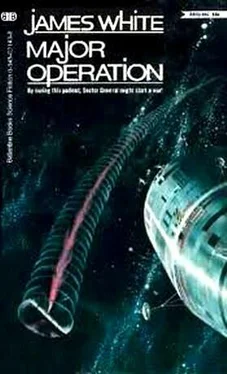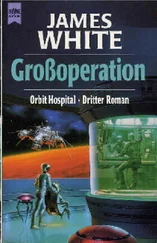“Straps.”
They hit their acceleration couches just as the three fast-gliding tools struck the hull, by accident or design, cutting off two of the external vision pickups. The one which was still operating showed a three-foot gash torn in the thin plating with a glider embedded in the tear, changing shape, stretching and widening it. Probably it was a good thing that they could not see what the other two were doing.
Through the gash in the plating Conway could see brightly colored plumbing and cable runs which were also being pushed apart by the tool. Then that screen went dead as well just as takeoff boost rammed him deep into the couch.
“Doctor, check the stern for stowaways,” said Harrison harshly as the initial acceleration began to taper off. “If you find any, think safe shapes at them-something which won’t scramble anymore of my wiring. Quickly.”
Conway had not realized the full extent of the damage, only that there were more red lights than usual winking from the control board. The pilot’s fingers were moving over his panels with such an intensity of gentleness that the harshness in his voice made it sound as if it was coming from a completely different person.
“The aft pickup,” said Conway reassuringly, “shows all three tools gliding in pursuit of our shadow.
For a time there was silence broken only by the tuneless whistling of air through torn plating and unretracted scanner supports. The surface wobbled past below them and the ship’s motion made Conway feel that it was at sea rather than in the air. Their problem was to maintain height at a very low flying speed, because to increase speed would cause damaged sections of the hull to peel off or heat up due to atmospheric friction, or increase the drag to such an extent that the ship would not fly at all. For a vessel which was classed as a supersonic glider for operations in atmosphere their present low speed was ridiculous. Harrison must be holding onto the sky with his fingernails.
Conway tried hard to forget the lieutenant’s problems by worrying aloud about his own.
“I think this proves conclusively that the strata creatures are our intelligent tool users,” he said. “The high degree of mobility and adaptability shown by the tools makes that very plain. They must be controlled by a diffuse and not very strong field of mental radiation conducted and transmitted by root networks and extending only a short distance above the surface. It is so weak that an average Earth-human or e-t mind can take local control.
“If the tool users were beings of comparable size and mental ability to ourselves,” he went on, trying not to look at the landscape lurching past below them, “they would have to travel under and through the surface material as quickly as the tools were flying over it if they were to maintain control. To burrow at that speed would require them being encased in a self-propelled armor-piercing shell. But this does not explain why they have ignored our attempts at making wide-range contact through remote-control devices, other than by reducing the communication modules to their component pieces …
“If the range of mental influence pervades its whole body,” Murchison broke in, “would that mean that the creature’s brain is also diffuse? Or, if it does have a localized brain, where is it?”
“I favor the idea of a centralized nervous system,” Conway replied, in a safe and naturally well-protected area-probably close to the creature’s underside where there is a plentiful supply of minerals and possibly in a natural hollow in the subsurface rock. Eye plant and similar types of internal root networks which you’ve analyzed tend to become more complex and extensive the closer we go to the subsurface, which could mean that the pressure-sensitive network there is augmented by the electro vegetable system which causes muscular movement as well as the other types whose function and purpose are still unknown to us. Admittedly the nervous system is largely vegetable, but the mineral content of the root systems means that electrochemical reactions generated at any nerve ending will transmit impulses to the brain very quickly, so there is probably only one brain and it could be situated anywhere.”
She shook her head. “In a being the size of a subcontinent, with no detectable skeleton or osseous structure to form a protective casing and whose body, relative to its area, resembles a thin carpet, I think more than one would be needed-one central brain, anyway, plus a number of neural substations. But the thing which really worries me is what do we do if the brain happens to be in or dangerously close to the operative field.”
“One thing we can’t do,” Conway replied grimly, “is delay the op. Your reports make that very clear.”
She had not been wasting time since coming to Drambo and, as a result of her analysis of thousands of specimens taken by test bores, diggers and exploring medics from all areas and levels of its far-flung body, she was able to give an accurate if not completely detailed picture of the creature’s current physiological state.
They already knew that the metabolism of the strata creature was extremely slow and that its muscular reactions were closer to those of a vegetable than an animal. Voluntary and involuntary muscles controlling mobility, ingestion and digestion, circulation of its working fluid and the breaking down of waste products were all governed or initiated by the secretions of the specialized plants. But it was the plants comprising the patient’s nervous system with their extensive root networks which had suffered worst in the roller fallout, because they had allowed the surface radioactivity to penetrate deep inside the strata creature. This had killed many plant species and had also caused the deaths of thousands of internal animal organisms whose purpose it was to control the growth of various forms of specialized vegetation.
There were two distinct types of internal organisms and they took their jobs very seriously. The large-headed farmer fish were responsible for cultivating and protecting benign growth and destroying all others- for such a large creature, the patient’s metabolic balance was remarkably delicate. The second type, which were the being’s equivalent of leucocytes, assisted the farmer fish in plant control and directly if one of the fish became injured or unwell. They were also cursed with the tidy habit of eating or otherwise absorbing dead members of their own or the fish species, so that a very small quantity of radioactive material introduced by the roots of surface plants could be responsible for killing a very large number of leucocytes, one after another.
And so the dead areas which had spread far beyond the regions directly affected by roller fallout were caused by the uncontrolled proliferation of malignant plant life. The process, like decomposition, was irreversible. The urgent surgical removal of the affected areas was the only solution.
But the report had been encouraging in some respects. Minor surgery had already been performed in a number of areas to check on the probable ecological effects of large masses of decomposing animo vegetable material on the sea or adjacent living strata creature, and to devise methods of radioactive decontamination on a large scale. It had been found that the patient would heal, but slowly; that if the incision was widened to a trench one hundred feet across, then the uncontrolled growth in the excised section would not spread to infect the living area, although regular patrols of the incision to make absolutely sure of this were recommended. The decomposition problem was no problem at all-the explosive growth rate continued until the plant life concerned used up the available material and died. On land the residue would subside into a very rich loam and make an ideal site for a self-supporting base if medical observers were needed in the years to come. In the case of material sliding off shelving coastlines into the sea, it simply broke up and drifted to the seabed to form an edible carpet for the rollers.
Читать дальше












